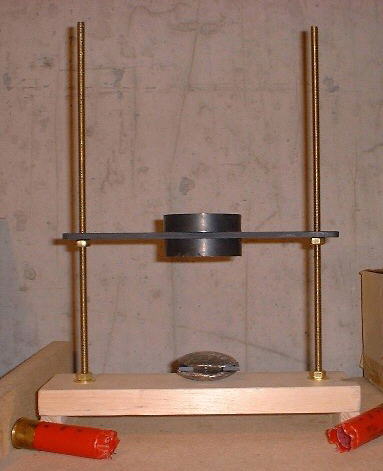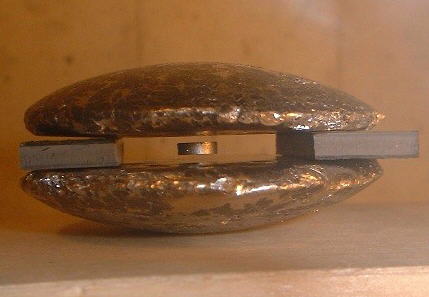

In spite of what Earnshaw said, I have always believed in the possibility of permenant magnet levitation. I found out about this at a very excellent web site called Scitoys.com. I highly recommend looking at it. I just had to try building one of these myself. It worked just like they said. The small magnet can be made to wobble around or spin by blowing on it. It is stable and always returns to its center position.
It is always annoying to me when someone flashes a bunch of mathematical mumbojumbo in our faces and says something is impossible. Many times the impossibility may be true in the true sense of the mathematical definition, but mathematical definitions often fall way short when evaluating our real and practical world. Someone named Earnshaw, using mathematical mumbojumbo, said that a permenant magnet can not be levitated without using some energy input for stabilization. In the practical sense, one would be a fool to take the Earnshaw therom seriously. The picture shows that permenant magnet levitation can easily be done at home.
The trick is a property of bismuth called diamagnetism. Diamagnetism is a property of a substance to be repelled instead of attracted by a magnet. It also has the peculiar property of not trying to rotate the magnet away from it during the repulsion. A diamagnetic material will be repelled from a magnet no matter what pole it is near. Diamagnetism probably does not fall within the definition of the Earnshaw therom but who cares.
The small floating magnet is repelled away from either of the bismuth plates and tends to stay in the center. The weight of the floating magnet though is many times greater than the diamagnetic force and would normally just sit on the bottom plate. The pull from the large magnet above however, is carefully adjusted to just counteract the floating magnet's weight.
I was able to achieve stable levitation with just one bismuth plate either above or below but the adjustment was more sensitive and the floating magnet, if jostled, could go unstable and either fall or be sucked up.
Bismuth seems to be one of the few materials that has enough diamagnetism to make this work easily. It can be obtained by taking bismuth shot from shotgun shells. They are a special kind that use bismuth shot instead of lead shot, to prevent lead poisoning to birds in hunting areas. Most of the bigger sports dealers carry the bismuth shells. I used two shells worth for each of the two bismuth plates shown. The shot was melted on my kitchen stove and poured into the bottom of an upside down pop can (it was handy as suggested by scitoys.com and is the only reason for their curved side).
For obvious reasons, be sure to remove the bismuth shot from the shells before trying to melt it. I did it by prying the end (the end opposite the brass) of the shells open. The best way however, seems to be by cutting the end open with a razor knife.
The picture is pretty self explanatory. It is important to use a Neodimium Iron Boron magnet as the floating magnet because it is powerful enough to produce an adequate amount of diamagnetic force. I got mine at Radio Shack. The two pieces of bismuth are separated by two pieces of plastic that were handy. This separation distance is best determined by experiment. I have two NIB magnets from Radio Shack and one floats straight as pictured while the other one tends to float in a somewhat slanted position. Perhaps the slanted magnet was manufactured crooked.
The other important thing is to use a big strong magnet as the lifting magnet above. It must have a large magnetic field, compared to the small space where the small magnet floats. This makes a small magnetic strength gradient in the space where the magnet floats. This gradient must be smaller than the force gradient from the diamagnetic repulsion in order to keep it from being suddenly sucked up as it rises. An example of a large magnetic field is the earths magnetic field. We notice very little change in its strength as we travel miles. An example of a small magnetic field is one from a magnet held in the hand. We notice a drastic change in field strength by moving just one inch. As can be seen in the picture, the large magnet above is simply two large ceramic disk magnets stuck together on a piece of plastic. It is also important to support the magnet and plastic on nuts so that the height can be carefully adjusted. There is a very specific height that must be found by experimentation and turning the nuts.
This levitating process is similar to that of placing a magnet above a superconductor. The only difference is that the superconductor has a very much larger diamagnetic force that is sufficient to support the weight of the floating magnet. The magnetic field pulling from above is not necessary.